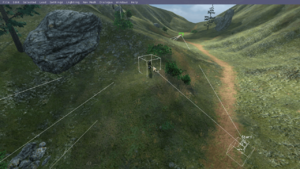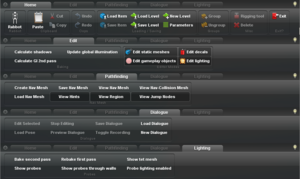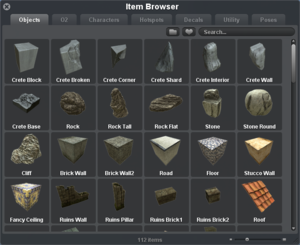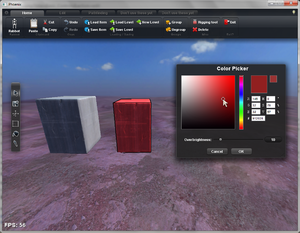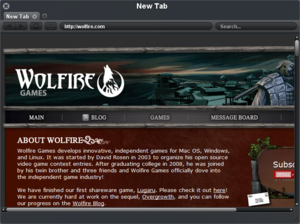Difference between revisions of "Editor Interface"
Silverfish (talk | contribs) (→Introduction: Edited to be up to date as of a226) |
(→Object Selection) |
||
| Line 248: | Line 248: | ||
|- | |- | ||
! Deselect all | ! Deselect all | ||
| − | | double-left-click away from all objects || Deselects all objects. | + | | Q key, or double-left-click away from all objects || Deselects all objects. |
|} | |} | ||
Revision as of 23:25, 6 December 2016
Contents
Introduction
This page details all the interface elements and actions in the Overgrowth level editor. It can be accessed by pressing the Editor button on the main menu, selecting one of the levels and then pressing escape when in the game.
Camera Movement
| Action | Control | Behavior |
|---|---|---|
| Forward | W | Moves camera forward. |
| Backward | S | Moves camera backward. |
| Left | A | Moves camera left. |
| Right | D | Moves camera right. |
| Up | Shift + W | Moves camera up. |
| Down | Shift + S | Moves camera down. |
Ribbon User Interface
The horizontal bar across the top of the window is called the ribbon. All editor functions can be found here with a few exceptions as some functions can only be reached via hotkeys for now.
Since this is alpha software, some buttons simply don't do anything at all. 'Cmd' refers to the '⌘' key on Macs, and the 'Ctrl' key on PCs.
Home
Contains the most common tools.
| Button | Hotkey | Effect |
|---|---|---|
| Rabbot | 8 | Enter play mode. |
| Paste | cmd+v | Pastes the clipboard on the cursor position. |
| Cut | cmd+x | Puts the selection into the clipboard and removes the selected objects. |
| Copy | cmd+c | Puts the selection into the clipboard. |
| Undo | cmd+z | Undo the most recent action. |
| Redo | cmd+shift+z | Redo the most recent action. |
| Load Item | cmd+l | Opens the item browser. |
| Save Item | cmd+shift+s | Opens a save dialog to save selected objects. |
| Load Level | - | - |
| Save Level | cmd+s | Overwrites the current level with any changes. |
| New Level | - | - |
| Parameters | - | Opens the parameter editor for the loaded level. |
| Group | cmd+g | Groups the selected objects. |
| Ungroup | cmd+shift+g | Ungroups any selected groups. |
| Rigging tool | - | - |
| Delete | delete | Removes any selected objects. |
| Exit | alt+f4 | Closes the application. |
Edit
Contains tools more directly related to level editing.
| Button | Hotkey | Effect |
|---|---|---|
| Calculate shadows | - | Starts baking shadows. |
| Calculate ambient occlusion | - | Starts an ambient occlusion bake. |
| Miss object tool | - | - |
| Material editor | - | - |
| Shader editor | - | - |
| Isolate | - | - |
| Projector box display | - | - |
| Surface display | - | - |
| Object editor active | cmd+1 | Toggle ability to select objects. |
| Hotspot editor active | cmd+3 | Toggle ability to select hotspots. |
| Decal editor active | cmd+2 | Toggle ability to select decals. |
| Physics editor active | - | - |
Pathfinding
Tools for nav mesh generation, loading, saving and viewing.
| Button | Hotkey | Effect |
|---|---|---|
| Create Nav Mesh | - | Generates a new navigation mesh. |
| View Nav Mesh | - | Renders the current nav mesh in the 3D view. |
| Save Nav Mesh | - | Save the current nav mesh to disk. |
| Load Nav Mesh | - | Load a previously saved nav mesh from disk. |
Dialogue
Tools for dialogue editing.
| Button | Hotkey | Effect |
|---|---|---|
| Edit Selected | - | ? |
| Load Pose | - | ? |
| Stop Editing | - | ? |
| Preview Dialogue | - | ? |
| Save Dialogue | - | ? |
| Toggle Recording | - | ? |
| Load Dialogue | - | ? |
Test
Contains an experimental tool for using the terrain to carve into objects.
| Button | Hotkey | Effect |
|---|---|---|
| Carve Against Terrain | - | Carves into selected objects with the terrain. |
Functions Without Buttons
Some functions are only reachable via hotkeys, here are a list of those.
| Action | Control | Behavior |
|---|---|---|
| Make player-controlled | Shift+Cmd+P | Toggles whether a character is controlled by a human or by AI. A human-controlled character's spawn box has a green outline, an AI-controlled character's box has white outlines. If two characters are set to be human-controlled Overgrowth will start in split-screen mode the next time game-play is resumed from editor mode. The second player will be controllable via a USB controller. |
| Parameter Editor | U (with object selected) | Opens the parameter editor to modify parameters of the selected object. |
| Palette Editor | Cmd+P (with character selected) | Brings up a dialog to modify colors of different parts of the character. |
| Color Picker | Cmd+P (with object that is not a character selected) | Brings up a dialog that can be used to tint the color of any selected objects. |
| Spawn Corpse | Cmd+K (with character selected) | Toggles corpse mode for the character. |
Object Selection
| Action | Control | Behavior |
|---|---|---|
| Select single object | double-left-click on object | Selects clicked on object and deselects all other objects. If the object is part of a group, the whole group is selected. Bounding box and slight glow indicate object is selected. |
| Toggle-select objects | shift + double-left-click on objects | Toggles whether or not clicked on object is selected. Preserves other existing selections. |
| Box select objects | left-click + right-click + drag, or left-click + 'b' + drag | Selects all objects whose centers lie within box drawn on screen. Deselects all other objects. |
| Box toggle-select objects | shift + left-click + right-click + drag, or shift + left-click + 'b' + drag | Toggles selection state for all objects whose centers lie within box drawn on screen. Preserves other existing selections. |
| Select decal that is under another decal | mouse wheel up/down | This only works when you have at least 2 decals and one is on top of another. You need to select at least 1 decal first and your mouse cursor needs to be on top of that one you want to select to do it |
| Select all | cmd-a | Selects all objects. |
| Deselect all | Q key, or double-left-click away from all objects | Deselects all objects. |
Transformations
For all transformations:
- In order to transform an object you must first select it.
- Hold ctrl to make movements snap by discrete increments.
- Hold alt to transform a clone of an object (or multiple objects), leaving the original object behind
- Left-click controls a 'generic' version of the transformation; right-click controls a version of the transformation contextually specific to the clicked on face. Holding shift locks the transformation to a single axis.
- Groups are transformed about the group center. Ungrouped objects, even if multiple are selected and transformed at once, are transformed about their own individual centers.
Translation
Set tool to 'translation', or set tool to 'omni tool' and hover mouse over central region of a bounding box face, or set tool to 'omni tool' and hold 't'.
| Action | Control | Behavior |
|---|---|---|
| Camera relative | left-click + drag | Translates clicked on object along plane parallel to the screen. |
| Locked to plane | right-click + drag | Translates clicked on object along plane of clicked on face. |
| Locked to line | shift + right-click + drag | Translates clicked on object along normal of clicked on face. |
| force decal(s) to map only one object/group | hold i | selected decal will only map with that object that is directly underneath your mouse |
| force decal(s) to project only on selected objects | press o | selected decal will only map with that object that is directly underneath your mouse |
| projection box/angle | press p | to make projection box for decal |
Scale
Set tool to 'scale', or set tool to 'omni tool' and hover mouse near bounding box vertices, or set tool to 'omni tool' and hold 'e'.
| Action | Control | Behavior |
|---|---|---|
| All dimensions | left-click + drag | Scales clicked on object in all dimensions (x, y, and z) at once. |
| Locked to plane | right-click + drag | Extends clicked on object along plane of clicked on face. |
| Locked to line | shift + right-click + drag | Extrudes clicked on object along normal of clicked on face. |
Mirror
Just use the right-click scale tool, and scale down the object until it flips and its mirror image begins scaling up!
Rotation
Set tool to 'rotation', or set tool to 'omni tool' and hover mouse near bounding box edges, or set tool to 'omni tool' and hold 'r'.
| Action | Control | Behavior |
|---|---|---|
| Free | left-click + drag | Rotates clicked on object as if you are pushing the surface of a ball. |
| Locked to axis | right-click + drag | Rotates clicked on object about normal of clicked on face. |
Warnings
Just below the ribbon on the left side is a space for warnings. These warnings will tell you if the nav mesh, ambient occlusion or baked shadows needs to be updated.
Item Browser
The item browser is used to browse for items that can be spawned in the levels. It is brought up by pressing the Load Item button under the Home tab. To spawn an item, click it and then click in the world to create the item on that location.
This list does not necessarily contain all the objects that can be spawned as all objects need to be manually added to the list. A file browser can be brought up by pressing the folder icon just under the tabs at the top. That file browser can be used to try loading any xml file, which is useful if you're trying to load a custom object that has not been added to the item browser for instance. The types of items that can be spawned are objects (static models), characters, weapons, hotspots, decals and spawn points.
Along the top of the window there are tabs for different categories of items. In the bottom right there is a slider to change the size of the thumbnail images as well as a grip that can be clicked and dragged to resize the window. A search field that searches in the currently open tab is located under the tabs to the right.
Hovering your mouse cursor over a thumbnail image causes a heart icon to appear on the thumbnail. If that heart icon is pressed the object is added as a favorite. To sort out any object that is not a favorite from the view, press the heart button right under the tabs at the top of the window. The favorites do not persist between closing and opening the item browser.
Color Picker
The Color Picker is used to tint the color of selected objects. It is opened by pressing CTRL+P (For Mac users: Command+P). The color picker consists of a color-gradient box, a rainbow slider, two boxes of different sizes showing the basic chosen color, RGB values, a hex value, and an overbrightness slider. Increasing overbrightness makes the color brighter.
Save Selected Objects
Once you have created something you wish to use elsewhere, press Ctrl+Shift+S (On Windows) or Command+Shift+S (on Mac) to open an object saving dialog. This way, you can save buildings, trees or obstacle courses made from many parts as a single XML object, ready to be imported back to Overgrowth.
Sun Editor
To edit the sun, find it in the sky and double-click it. Now you can click and drag on the circle to change the intensity of the sun, click and drag on the dot to change the color and click and drag on the sun itself to move it around the sky.
Dialogue Editor
The dialogue editor is used to create scenes with different camera angles, text and poses. It is commonly used to give context and progress the story in a level.
Getting Started
Write the dialogue
Create a text file in your mods Dialogues folder (../Overgrowth/Data/Dialogues) and write the dialogue in it like this.
#name "Mirage" #participants 1 say 1 "Thorn" "You there!" say 1 "Thorn" "Do you have any..[wait 0.4] water?"
- The #name "Mirage" is the name of the scene. This is given to a dialogue hotspot on so it knows which dialogue to activate.
- The #participants 1 is how many characters there are in the scene. The numbered boxes above the dialogue object are connected to spawn points to decide which character is which in this scene.
- say at the beginning of a line is used to make someone say something.
- The 1 is the ID of the participant that should say the dialogue, this decides who moves their mouth when the dialogue appears.
- "Thorn" is which name should appear for the dialogue
- The text within the quotes at the end of the line is the dialogue itself.
- The [wait 0.4] will make the dialogue text pause for 0.4 seconds before continuing to display the next text.
Save and close the file.
Set up the scene
Open up your level in the game, go to the Dialogue tab in the ribbon and click Load Dialogue. Select the dialogue file you created and click in your level to spawn it there.
There is a small box above the dialogue object that you just created. Select this object and alt-click on a character to tell the game that the participant with ID 1 is that character.
Select the box and press Edit Selected, bringing up the text of the dialogue on the screen. Use the arrow up and down keys to select what line in the scene you want to edit. Now press Toggle Recording, which creates a few more useful objects in our scene:
- Camera (with accompanying preview window)
- Torso control
- Head control
- Eye control
Move the camera to choose where the camera will be when the dialogue reaches the selected line, scale it to zoom in or out. Move the torso, head and eye controls to choose where the character's torso, head and eye should be pointing at that point. You need to scale up the torso and head controls for them to have any effect.
Press Load Pose and find the files with names that start with r_dialogue, find one that you think might fit and load it to make the character take that pose when the scene loads.
Press Preview Dialogue to test the scene. When you're happy, click Toggle Recording again to turn it off and press Save Dialogue to save your changes to the scene.
Trigger the scene
Now we have the scene set up, but we don't have anything that triggers it yet. We can use a dialogue hotspot to make that happen. So go to the Home tab and press Load Item, go to the Hotspots tab, click the Start Dialogue hotspot and click on the ground in your level. This should spawn a wireframe cube with a green sign icon in.
The dialogue will trigger when the player enters this hotspot, so place it where it will trigger when you want it to. Just make sure the player spawn is not inside of the hotspot, as that won't work when the level is restarted.
Press U with the hotspot selected and change the Dialogue property to be the same as the #name setting in the dialogue you want to trigger. If you've followed this example, that would be Mirage.
Now save your level, start playing, enter the hotspot, and the dialogue should trigger!
Spawn Corpse
To make a character spawn as a corpse, select it and press cmd+K to toggle corpse mode. Its spawn box will turn red and the character will now be a corpse when it spawns.
Web browser
There is a web browser that can be brought up by pressing f1.
